
Use the technique that we used in Example 7 to do Exercises 51 –54. We do not list duplicate information in the tables.
Repeat Exercise 51 using this new table of information.
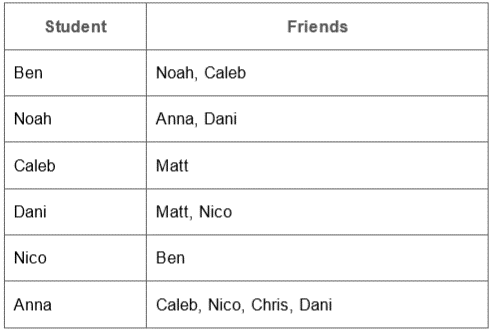
The table summarizes the Facebook “is a friend of” relationship among eight people.
a. Draw a graph to represent this situation
b. Is the graph connected?
c. Does the graph have any bridges?
d. Would it affect the communication within this group if Caleb and Ben unfriend each other?
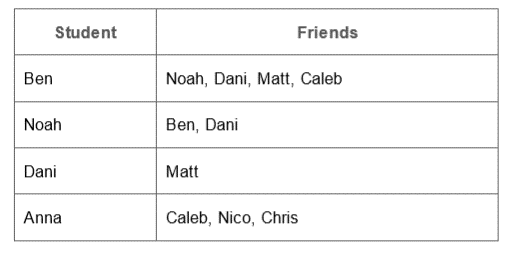
Example 7 Using a Graph Theory Model to Schedule Committees
Each member of a city council usually serves on several committees to oversee the operation of various aspects of city government. Assume that council members serve on the following committees: police, parks, sanitation, finance, development, streets, fire department, and public relations. Use Table 4.1, which lists committees having common members, to determine a conflict-free schedule for the meetings. We do not duplicate information in Table 4.1. That is, because police conflicts with fire department, we do not also list that fire department conflicts with police.
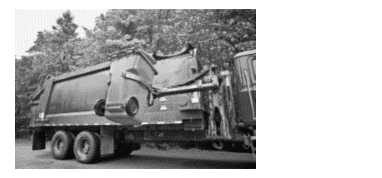
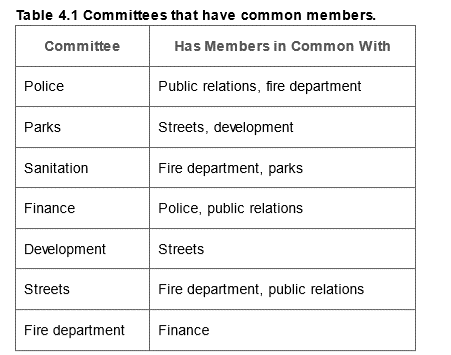
Solution: Recall that in building a graph model, we must have two things:
A set of objects—in this case, the set of committees.1. A relationship among the objects. We will say that two committees are related if the two committees have members in common. So we can model the information in Table 4.1 by the graph in Figure 4.19.
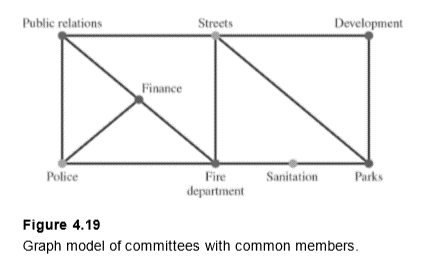
This problem is similar to the map-coloring problem. If we color this graph, then all vertices having the same color represent committees that can meet at the same time. We show one possible coloring of the graph in Figure 4.1.
From Figure 4.19, we see that the police, streets, and sanitation committees have no common members and therefore can meet at the same time. Public relations, development, and the fire department can meet at a second time. Finance and parks can meet at a third time.
Want to see the full answer?
Check out a sample textbook solution
Chapter 4 Solutions
MYLAB W/ETEXT FOR MATHEMATICS ALL AROUN
- In a study on speed control, it was found that the main reasons for regulations were to make traffic flow efficient and to minimize the risk of danger. An area that was focused on in the study was the distance required to completely stop a vehicle at various speeds. Use the following table to answer the questions. MPH Braking distance (yrds) 5 10 10 17 20 27 30 50 40 60 50 100 60 150 70 200arrow_forwardCClever Portal CA Co Managed bookmarks ixl.com/math/geometry/surface-area-and-volume-review?ImsPlatform=1 IXL My IXL Learning Assessment Geometry > U.15 Surface area and volume review TER C Learn with an example or ► Watch a video What is the surface area of this cone? Use л ≈ 3.14 and round your answer to the nearest hundredth. 7 ft 8 ft Submit square feet Type here to search Work it out Not feeling ready yet? These can help: 0 F1 1 2 F2 F3 #3 X F4 C F5 $ 4 % L E F6 + 回 F7 F8 F9 & об гarrow_forwardIn Gallup's Annual Consumption Habits Poll, telephone interviews were conducted for a random sample of 1014 adults aged 18 and over. One of the questions was, "How many cups of coffee, if any, do you drink on an average day?" The following table shows the results obtained (Gallup website, August 6, 2012). Number of Cups per Day 0 1 2 3 4 or more Number of Responses 365 264 193 91 101 Define a random variable x = number of cups of coffee consumed on an average day. Let x=4 represent four or more cups. a. Develop a probability distribution for x. b. Compute the expected value of x. c. Compute the variance of x. d. Suppose we are only interested in adults who drink at least one cup of coffee on an average day. For this group, let y = the number of cups of coffee consumed on an average day. Compute the expected value of y and compare it to the expected value of x.arrow_forward
- Ten major college football bowl games were played in January 2010, with the University of Alabama beating the University of Texas 37 to 21 to become the national champion of college football. The results of the 10 bowl games follow (USA Today, January 8, 2010). Bowl Game Score Outback Gator Auburn 38 Northwestern 35 Florida State 33 West Virginia 21 Capital One Penn State 19 LSU 17 Rose Ohio State 26 Oregon 17 Florida 51 Cincinnati 24 Sugar Cotton Alamo Fiesta Mississippi State 21 Oklahoma State 7 Texas Tech 41 Michigan State 31 Boise State 17 TCU 10 Orange Iowa 24 Georgia Tech 14 Championship Alabama 37 Texas 21 Predicted Point Margin Actual Point Margin 5 3 1 12 3 -2 14 3 9 -4 -3 4 229740706 14 10 10 16 The predicted winning point margin was based on Las Vegas betting odds approximately one week before the bowl games were played. For example, Auburn was predicted to beat Northwestern in the Outback Bowl by five points. The actual winning point margin for Au- burn was three points. A…arrow_forwardIn 2007 the New York Times reported that the median annual household income in the United States was $55,500 (New York Times website, August, 21, 2013). Answer the following questions based on the following sample of 14 household incomes for 2013 ($1000s). 49.4 52.2 52.4 53.4 51.3 52.1 48.7 64.5 51.6 46.5 52.9 52.5 52.1 51.2 a. What is the median household income for the sample data for 2013? b. Based on the sample data, estimate the percentage change in the median household income from 2007 to 2013. c. Compute the first and third quartiles.arrow_forwardEvaluate the triple integral 3' 23 HIG 2 +3 f(x, y, z)dxdydz where f(x, y, z) = x + 2x-y ม u = v = and w = 2 2 3 Triple Integral Region R -2 x N 2 y 3arrow_forward
- Find the volume of the solid bounded below by the circular cone z = 2.5√√√x² + y² and above by the sphere x² + y²+z² = 6.5z.arrow_forwardElectric charge is distributed over the triangular region D shown below so that the charge density at (x, y) is σ(x, y) = 4xy, measured in coulumbs per square meter (C/m²). Find the total charge on D. Round your answer to four decimal places. 1 U 5 4 3 2 1 1 2 5 7 coulumbsarrow_forwardLet E be the region bounded cone z = √√/6 - (x² + y²) and the sphere z = x² + y² + z² . Provide an answer accurate to at least 4 significant digits. Find the volume of E. Triple Integral Spherical Coordinates Cutout of sphere is for visual purposes 0.8- 0.6 z 04 0.2- 0- -0.4 -0.2 04 0 0.2 0.2 x -0.2 04 -0.4 Note: The graph is an example. The scale and equation parameters may not be the same for your particular problem. Round your answer to 4 decimal places. Hint: Solve the cone equation for phi. * Oops - try again.arrow_forward
- The temperature at a point (x,y,z) of a solid E bounded by the coordinate planes and the plane 9.x+y+z = 1 is T(x, y, z) = (xy + 8z +20) degrees Celcius. Find the average temperature over the solid. (Answer to 4 decimal places). Average Value of a function using 3 variables z 1- y Hint: y = -a·x+1 * Oops - try again. xarrow_forwardFind the saddle pointsarrow_forwardProblem #5 Section A of my math class has 110 students. Section B of my math class has 80 students. a). If I randomly select 15 students from the combined classes, in a way that the order of my selection does not matter, what is the probability that all 15 students can from Section A? b). If I randomly select 15 students from the combined classes, in a way that the order of my selection does not matter, what is the probability that all 15 students can from Section B? c). If I randomly select 15 students from the combined classes, in a way that the order of my selection does not matter, what is the probability that all 7 students come from section A and 8 students come from section B?arrow_forward
 Glencoe Algebra 1, Student Edition, 9780079039897...AlgebraISBN:9780079039897Author:CarterPublisher:McGraw Hill
Glencoe Algebra 1, Student Edition, 9780079039897...AlgebraISBN:9780079039897Author:CarterPublisher:McGraw Hill Algebra: Structure And Method, Book 1AlgebraISBN:9780395977224Author:Richard G. Brown, Mary P. Dolciani, Robert H. Sorgenfrey, William L. ColePublisher:McDougal Littell
Algebra: Structure And Method, Book 1AlgebraISBN:9780395977224Author:Richard G. Brown, Mary P. Dolciani, Robert H. Sorgenfrey, William L. ColePublisher:McDougal Littell Holt Mcdougal Larson Pre-algebra: Student Edition...AlgebraISBN:9780547587776Author:HOLT MCDOUGALPublisher:HOLT MCDOUGAL
Holt Mcdougal Larson Pre-algebra: Student Edition...AlgebraISBN:9780547587776Author:HOLT MCDOUGALPublisher:HOLT MCDOUGAL- Algebra & Trigonometry with Analytic GeometryAlgebraISBN:9781133382119Author:SwokowskiPublisher:Cengage
 Big Ideas Math A Bridge To Success Algebra 1: Stu...AlgebraISBN:9781680331141Author:HOUGHTON MIFFLIN HARCOURTPublisher:Houghton Mifflin Harcourt
Big Ideas Math A Bridge To Success Algebra 1: Stu...AlgebraISBN:9781680331141Author:HOUGHTON MIFFLIN HARCOURTPublisher:Houghton Mifflin Harcourt




